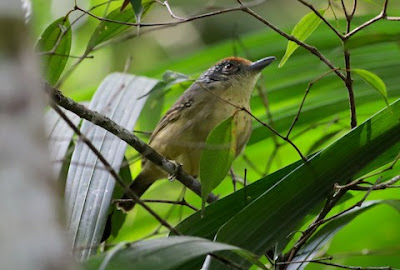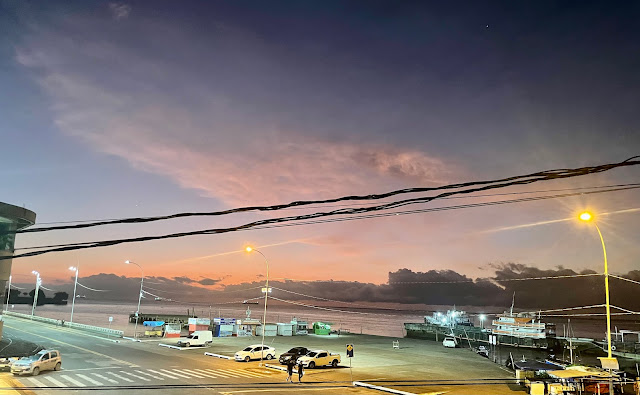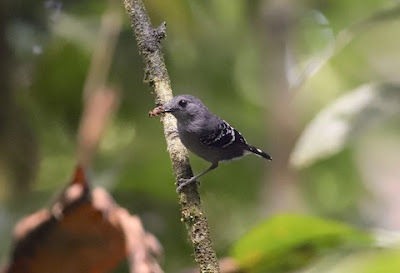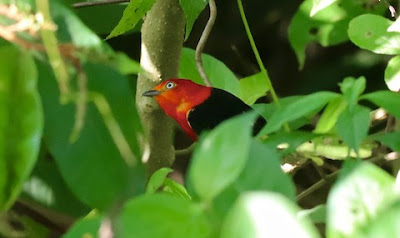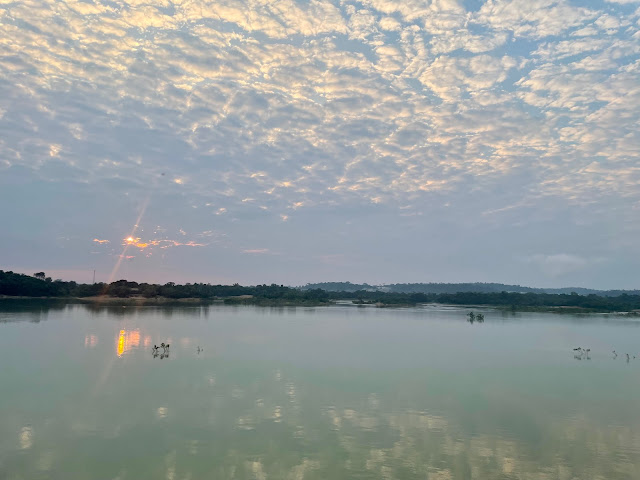January 2023: Senegal
Part 2 - The South East and the South West
After the Sahel adventure we aimed to squeeze every last bird out of Senegal and so made a long drive to the South East of the country before hooking back to the seldom-visited South Western corner.
Sunday, February 5 - Travel to the SouthEast
After a final morning birding forests around Tabacouta it was time to head off to new parts of the country. A long drive was punctuated by frequent birding stops and even a few goodies like Sahel Paradise-Whydah and Rüppell's Griffon. As we travelled, the habitat slowly changed with more trees, more raptors, and a more typically 'African feel' with rocky outcroppings, thorn trees, and small villages scattered along the route. Out based for the next three nights was a very comfortable Relais et Châteux hotel in Kedougou which was obviously the hub for traveling businessmen from France and beyond. For us it was a great base to explore the local area and get to grips with it's special birds.
Having time to spare in the afternoon we went to a local 'stakeout' for Mali Firefinch, an area of rugged cliffs were we hiked up in search of water sources what would attract the birds. Sure enough the fire finches appeared on cue and so we settled in to scan the rocky slopes in the hope of some Neumann's Starlings. While we waited we enjoyed Adamawa Turtle-Dove, Mocking Cliff-Chat, and even a Lanner Falcon along the cliffs. Ethan, as usual, spotted the starlings when a group of 18 (a record count for the country in eBird) moved along the cliffs above us giving excellent scope views.
 |
| Mali Firefinch and Piapiac. |
Monday - Wednesday, February 6-8 - Kedougou area
Three days to explore the habitats around Kedougou saw us driving roads through the sandy forest and walking off-road along cattle/game trails to get closer to the birds. We saw a lot of new species with notables including Dorst's Cisticola, Sun Lark, and Heuglin's Masked-Weaver. The key event here though was a day-trip to the permanent water at Dindefelo which boasts a number a special birds. A pair of Willcock's Honeyguides have taken up residence along the stream here, a tiny spot on the range map way outside their normal range, and we found them easily in their 'usual' tree. Further up the stream, a thorough search finally turned up the hoped for Dybowski's Twinspots and they uncharacteristically stuck around to give us good looks and even some photos. This is a bird with quite a broad range on the map but with practically no reliable sites to go find one on demand, having them here and cooperative was a real treat. One of the highlights of the whole trip even if our excitement was perhaps a little confusing to the local villagers who use the stream here to do their laundry.
 |
| OK, not the best photo ... but they're Dybowki's Twinspots! |
Thursday/Friday, February 9/10 - Wassadou
Turning around and heading back West for a morning of driving, along with a few good roadside birds like Abyssinian Ground-Hornbill, brought us to the famous Campement de Wassadou. The delightful lodge, high on a bluff at a bend in the Gambia River has a stunning concentration of birds gathered at the permanent water. There are also hippos, baboons, antelopes and other wildlife, something we saw very little of otherwise on our trip.
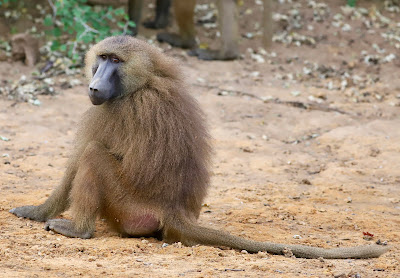 |
| Guinea Baboon and Bushbuck. |
After a nice lunch and a siesta we gathered at the boat dock for our 'touristy' boat ride, fending off several groups of non-birding French adventure-tourists to get the boat we'd booked. Even with our first choice, the boat was sitting pretty low in the water but it seemed calm enough and so we drifted off down the river hoping the hippos kept to themselves.
 |
| Pied, Gray-headed and Blue-breasted Kingfishers. |
There is something very pleasant about drifting down a river in a canoe, birds are relatively tame and sit close without flushing, and there's always the chance of surprising some other wildlife as you drift quietly round a bend. Highlights here included Egyptian Plovers and Senegal Thick-knees, many kingfishers and bee-eaters, Hamerkop, and Wattled and White-crowned Lapwings. The star bird though took a little more effort, a roosting White-backed Night-Heron was so well hidden that, even though the boatman knew exactly where it was, he had to re-position the canoe several times to give each person a glimpse into the narrow window in the dense bushes that allowed a view.
 |
| Egyptian Plover and Hamerkop. |
That night we spent a little time hoping for the resident Pel's Fishing-Owls but unfortunately drew a blank ... this bird is on its way to being a nemesis bird of sorts for me, I've now missed it in several places. Next morning I woke up several hours before sunrise and spotlighted around the camp and river hoping that the owls would be more cooperative, but alas no.
In the daylight though we walked back down the river and picked up a few things we'd missed the day before, most notably African Finfoot (completes my personal set of the three finfeet? finfoots?), Bronze-tailed Starling and Oriole Warbler. A tough spot to tear yourself away from but eventually we had to move on. Lovely location, highly recommended.
 |
| Red-throated Bee-eater and Northern Carmine Bee-eater. |
Saturday, February 11 - Forêt de Djibelor
But onwards towards our new base at Ziguinchor, stopping to check out some forest patches and fragments. The forest here, what was left of it anyway, was wetter, and the birds were quite different with many new species joining our Senegal lists. This area of Senegal had been largely closed to outsiders for much of the last 30-40 years because of a local insurgency and general instability. Things seem to have settled down a bit now so we felt good about exploring, especially in a place where the birds were so little studied. Unfortunately though, the peace that allowed us access to the area had also been a very bad thing for the forests which were being cleared at an alarming rate; some forest patches we had been directed to bird were simply no longer there. Still, we were in new country and were going to make the most of it enjoying birds like Ahanta Spurfowl, Snowy-crowned Robin-Chat, Black-headed Paradise Flycatcher and even a day-calling Verraux's Eagle-Owl.
Sunday, February 12 - Mpak
Early next morning saw us in a scrap of forest and farmland right up against the border with Guinea-Bissau and me trying unsuccessfully to persuade the group to head down one of the smugglers trails to do some 'border-flirting' and get a new country on the eBird map (smarter heads prevailed). Our target here was the Turati's Boubou, a bird recently discovered in Senegal and known from this one small area along the border. We headed into the forest full of expectations and started to add a lot of new West African birds to our Senegal lists. We had Western Nicator and Leaflove, Green Crombec and Green Hylia, Western Bluebill, Piping Hornbill and a really nice selection of forest birds ... but no boubou. Admitting defeat we returned to the vehicle and stopped for a chat at the village (always good to be social and seek permission from local villagers, wherever you are in the world). In conversation with the village chief, Ethan mentioned the boubou, showed him a picture and played him the song and the chief surprised us all by saying he knew the bird well and that we had been looking in the wrong place. He led us to an area of village fields with some scattered scrub patches and sure enough, we had multiple singing Turati's Boubou and we able to pull some in to tape. Local knowledge trumps the field guide yet again.
 |
| Green Hylia in the green forest |
We also managed to squeeze in a visit to some local grasslands where we added a surprise record of Black-backed Cisticola (first eBird record for Senegal ... but then this area is less studied given the lack of access over the years), Yellow-throated Longclaw, Plain-backed Pipit and a nice selection of marsh birds.
Monday, February 13 - Diembéring Ecoparc
Our last day of birding and a few more targets to chase down. Our main goal here with the Capuchin Babbler, a vexing species that may in fact be 2 or 3 different species. It's also a bit of a skulker but after a couple of hours of work we managed to get a cooperative family group and get some good views.
 |
| Capuchin Babbler ... skulking ... |





























